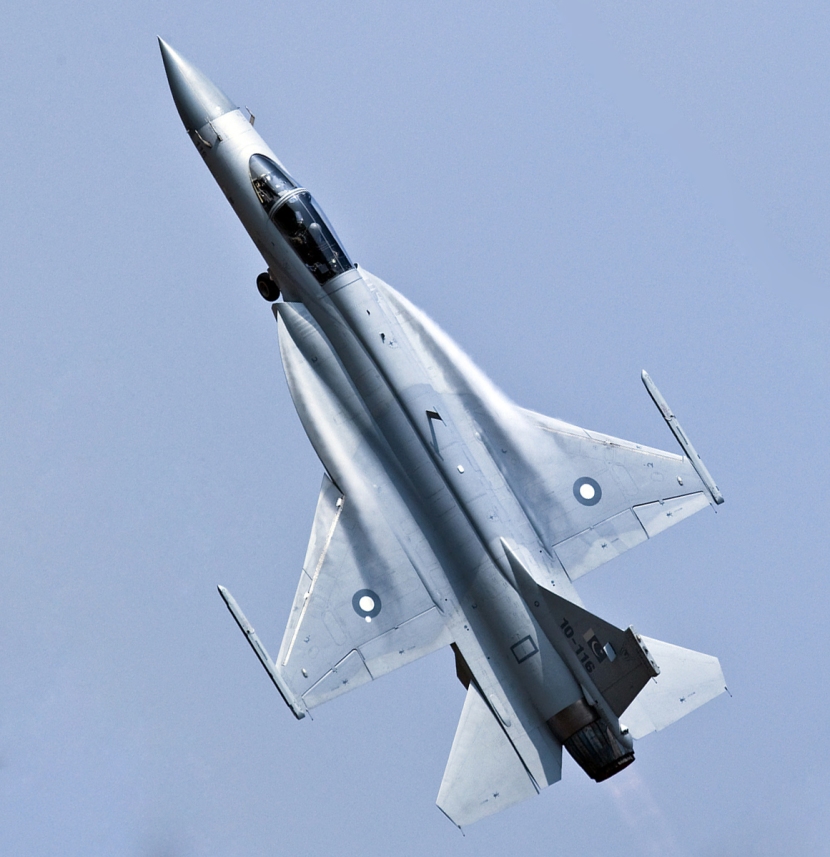So how good is Pakistan’s JF-17 fighter? Analysis from RUSI think-tank’s Justin Bronk

Created in China, perhaps based on an Russian idea, the JF-17 is solely in service with the Pakistan Air Force. Comparable in thrust and weight levels to the Swedish Gripen, the JF-17 is an intriguing design, but how effective is it? We asked Justin Bronk, from the Royal United Services Institute for his opinion.
“The JF-17 as an airframe is certainly competitive with the F-16, being slightly aerodynamically cleaner, with a lower wing loading but a less efficient engine than the F-16s latest F110-GE-129/132 engine options. In terms of pilot interface, sensor suite and weapon flexibility, the JF-17 is roughly at a par with 1990s-vintage F-16 Block 40/42 and could be close to the USAF-standard Block 50/52, although without the conformal fuel tanks, JHMCS helmet sighting system and radar upgrades which distinguish the later Block 50/52+ and AESA which equips the UAE’s Block 60/61s.”

How would you rate the JF-17 in terms of within-visual range (WVR) and beyond-visual range (BVR) fightercapabilities?
“WVR, equipped with the MAA-1 Piranha missile, the small and agile JF-17 will be a dangerous but not exactly world-beating opponent for existing fourth generation fighters. It is limited to +8/-3g and the current block 1 and 2 fighters do not yet have a helmet mounted sight system as standard (this is promised for block 3). The JF-17 also doesn’t have a greater than 1:1 thrust to weight ratio so would be at a significant disadvantage in terms of energy management against opponents such as the F-15C, Typhoon or Su-35. BVR, the KLJ-7 radar is significantly out-ranged by the F-16’s AN/APG-68 and completely outclassed by the Rafale’s AESA array, Typhoon’s CAPTOR-M and the Su-35’s monstrously powerful Irbis-E. The JF-17s small wing area and lightweight also limit its missile-carrying capacity which further disadvantages it in BVR engagements. However, it is worth remembering that the JF-17 is not really intended to take on Typhoons, Rafales, F-15s or Su-35s. It is meant to be a cheap and cheerful light multirole fighter and configured accordingly.”

For the full article go here
https://hushkit.net/2018/01/25/so-h...-analysis-from-rusi-think-tanks-justin-bronk/

Created in China, perhaps based on an Russian idea, the JF-17 is solely in service with the Pakistan Air Force. Comparable in thrust and weight levels to the Swedish Gripen, the JF-17 is an intriguing design, but how effective is it? We asked Justin Bronk, from the Royal United Services Institute for his opinion.
“The JF-17 as an airframe is certainly competitive with the F-16, being slightly aerodynamically cleaner, with a lower wing loading but a less efficient engine than the F-16s latest F110-GE-129/132 engine options. In terms of pilot interface, sensor suite and weapon flexibility, the JF-17 is roughly at a par with 1990s-vintage F-16 Block 40/42 and could be close to the USAF-standard Block 50/52, although without the conformal fuel tanks, JHMCS helmet sighting system and radar upgrades which distinguish the later Block 50/52+ and AESA which equips the UAE’s Block 60/61s.”

How would you rate the JF-17 in terms of within-visual range (WVR) and beyond-visual range (BVR) fightercapabilities?
“WVR, equipped with the MAA-1 Piranha missile, the small and agile JF-17 will be a dangerous but not exactly world-beating opponent for existing fourth generation fighters. It is limited to +8/-3g and the current block 1 and 2 fighters do not yet have a helmet mounted sight system as standard (this is promised for block 3). The JF-17 also doesn’t have a greater than 1:1 thrust to weight ratio so would be at a significant disadvantage in terms of energy management against opponents such as the F-15C, Typhoon or Su-35. BVR, the KLJ-7 radar is significantly out-ranged by the F-16’s AN/APG-68 and completely outclassed by the Rafale’s AESA array, Typhoon’s CAPTOR-M and the Su-35’s monstrously powerful Irbis-E. The JF-17s small wing area and lightweight also limit its missile-carrying capacity which further disadvantages it in BVR engagements. However, it is worth remembering that the JF-17 is not really intended to take on Typhoons, Rafales, F-15s or Su-35s. It is meant to be a cheap and cheerful light multirole fighter and configured accordingly.”

For the full article go here
https://hushkit.net/2018/01/25/so-h...-analysis-from-rusi-think-tanks-justin-bronk/
